Jordan week of wonders
Glorious wildflowers, dramatic scenery, Petra, Bedouin, a day in the desert – and a great deal more, with outstanding guide Oron Peri
20 – 28 March 2017
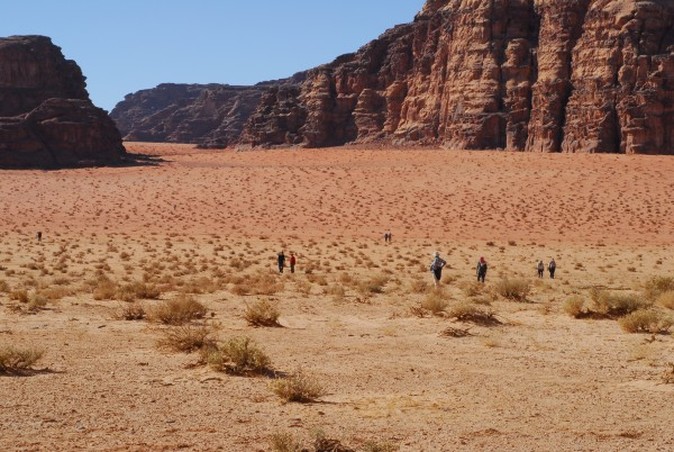
Yes, we had a sensational week, as Jorun Tharaldsen’s photos show so well. There were 24 of us discovering Jordan’s spring wildflowers and some of the historic sites with botanical guide Oron Peri and local Palestinian guide Nasser.
Oron explained that Jordan with about 85 per cent desert is one of the five driest countries in the world, last autumn having been particularly parched (two months without rain in what should have been the rainy season). Water, or the lack of it, is the critical issue, as is the ever-creeping desert. But as the variety of habitats in the country might change every 50km or so, ranging from a typical Mediterranean terrain in the north towards the Syrian border to the southern desert at Wadi Rum, there would still be plenty to see.
Our first excursion was cultural rather than botanical. The town of Madaba is famed for its Byzantine mosaics, particularly in St George’s Greek Orthodox Church where a celebrated mosaic map of the Holy Land dating from around 560 AD covers much of the floor. Such is the sad state of tourism in the country that we had the church to ourselves and ample opportunity to study the map’s geographically accurate details – Jerusalem in the centre, Lebanon to the north, the Nile delta to the south, the Mediterranean coast to the west, and endless desert to the east, plus noted biblical locations accurately sited and labelled in Greek, along with exquisite depictions of the Jordan river and Dead Sea, animals, trading customs and agriculture. Truly a work of art, if incomplete, only unearthed in 1884, and worth googling for images.
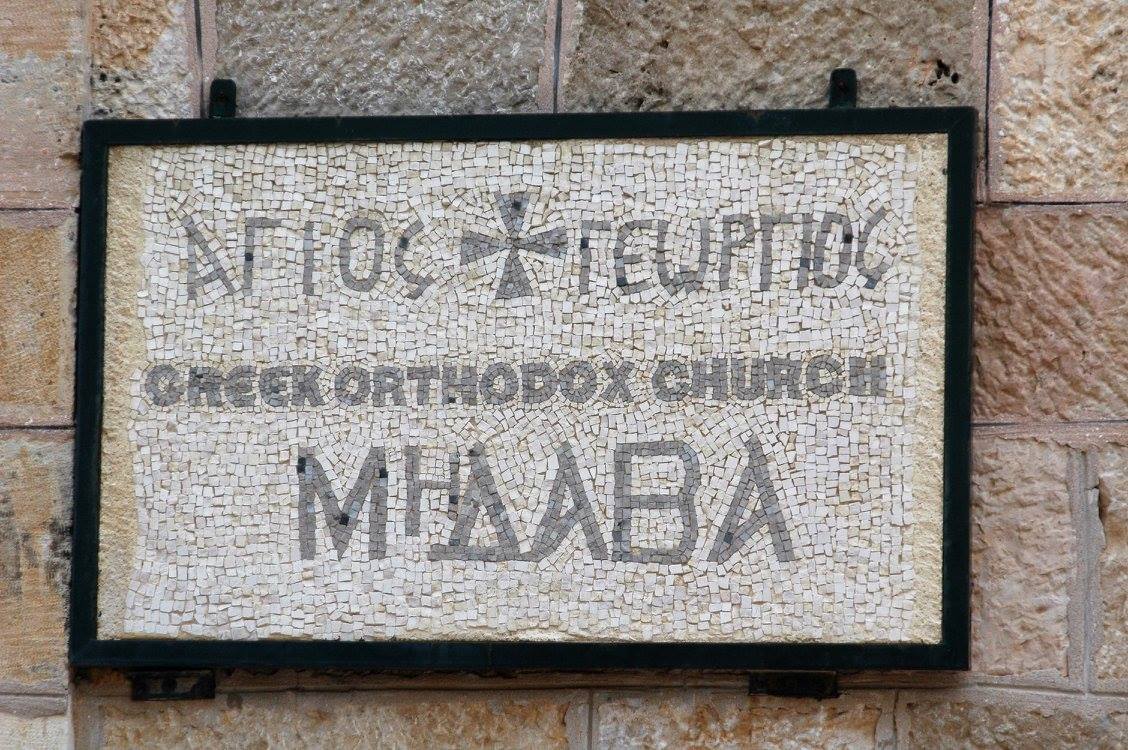
Soon we were en route northwest along the Jordan valley towards Mount Nebo, stopping to tramp up a stony hillside and our first sightings of hundreds of wildflowers (up to 500 species on this one site alone, Oron told us). And unfortunately it should be added that there were at least 500 species of plastic rubbish here and almost everywhere we went too – one of the few downsides to Jordan’s beautiful habitats.
Oron tackles such locations like a mountain goat with the eye of a hawk to the ground – at a distance in an unprepossessing parched patch he spotted our first Gagea reticulata of the week (this one barely open but we found many members of this genus all over the place subsequently), Moraea sisyrinchium, shining sunny Ranunculus millefolius, a rich purple poppy Roemeria hybrida, a pink and a white Tragapogon, and the very dramatic Aristolochia bottae. Bright green mounds of Euphorbia hyerosolymitana nestled between granite boulders. Tulips, anemones, geraniums including Geranium tuberosa (the Bedouin eat the tubers), the field marigold Calendula arvensis (many well-known medicinal uses), wild asparagus – and so much more. Under Aleppo pines a smiling Bedouin boy was alternately singing to his sheep and urging them onwards with his energetic dog. What a pastoral start to our plant hunting. But were those sheep munching away at what we had come so far to find?
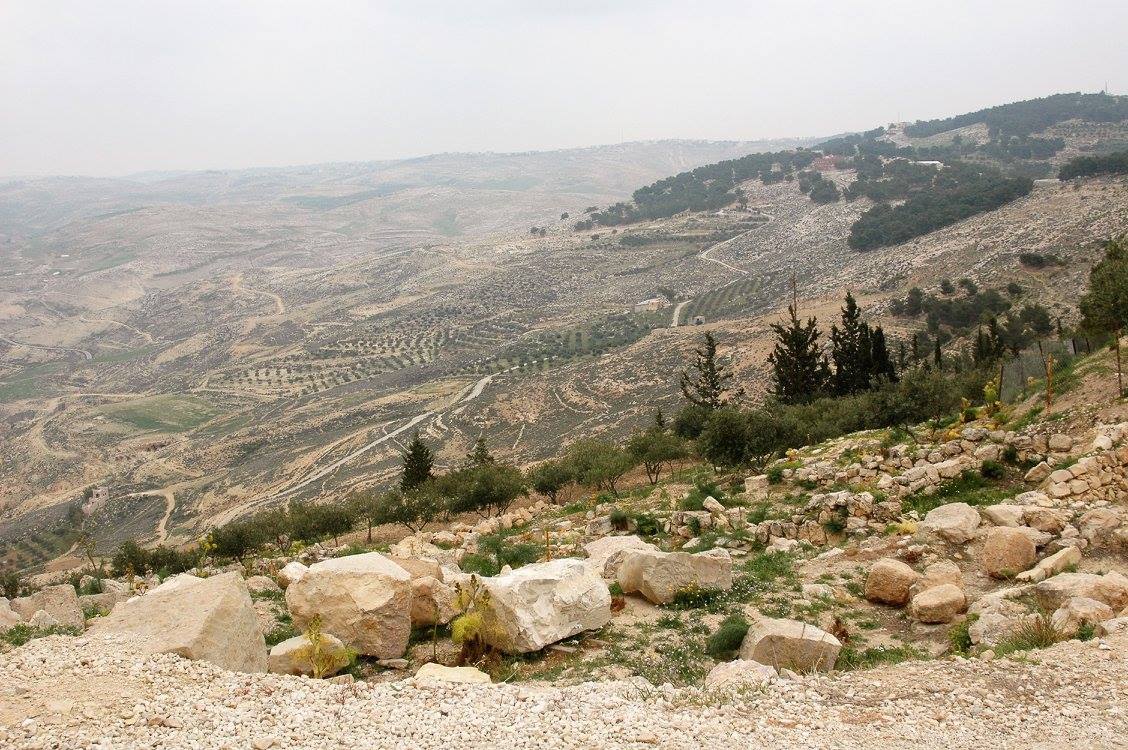
We drove on up to the holy site of Mount Nebo from where Moses is said to have gazed over The Promised Land, and where it is widely believed he is buried. Aside from more lively (lively and lovely actually) mosaics, what truly takes your breath totally away are the gigantic views on all sides of desert landscape and folded mountains. Sadly it was too hazy to see clearly to Jericho on the west bank of the Jordan river or the Mount of Olives in Jerusalem. To gaze into the distance here was a long moment to reflect on the tides of Middle Eastern history (and the vast gaps in my knowledge, biblical and otherwise).
I could have stood and stared here for hours in changing lights.
Here too was a moment to contemplate how Jordan is part of the Great Rift Valley stretching from Lebanon, via the Jordan valley, the Dead Sea, Gulf of Aqaba, Red Sea, and on down to Mozambique. Thus much of the extensive flora has African origins, hence its huge variety. The valley temperatures go from warm to extremely hot, only the Bedouin have perfected the art of desert living. We drove on up the Jordan valley towards our hotel outside the city of Jerash, home of its extensive Roman city.
En route, a magic moment: in Wadi Shueib (wadi = ravine) our first sighting of one of Jordan’s black iris species, Iris haynei – (right) utterly beautiful and mysterious against blue sky perched at the top of a slope. Having got our eye in we saw more and more of them, although they were hard to reach. Oron describes them as a ‘robust’ species. The intensely deep purple sepals (falls) contrast with their yellow beards. We passed Bedouin, with their merry children and tethered donkey, and, comically, a broken rusty wheelbarrow parked way up the single tree. Why go to the effort of dumping it up there? Too many rust holes to offer much donkey shade.
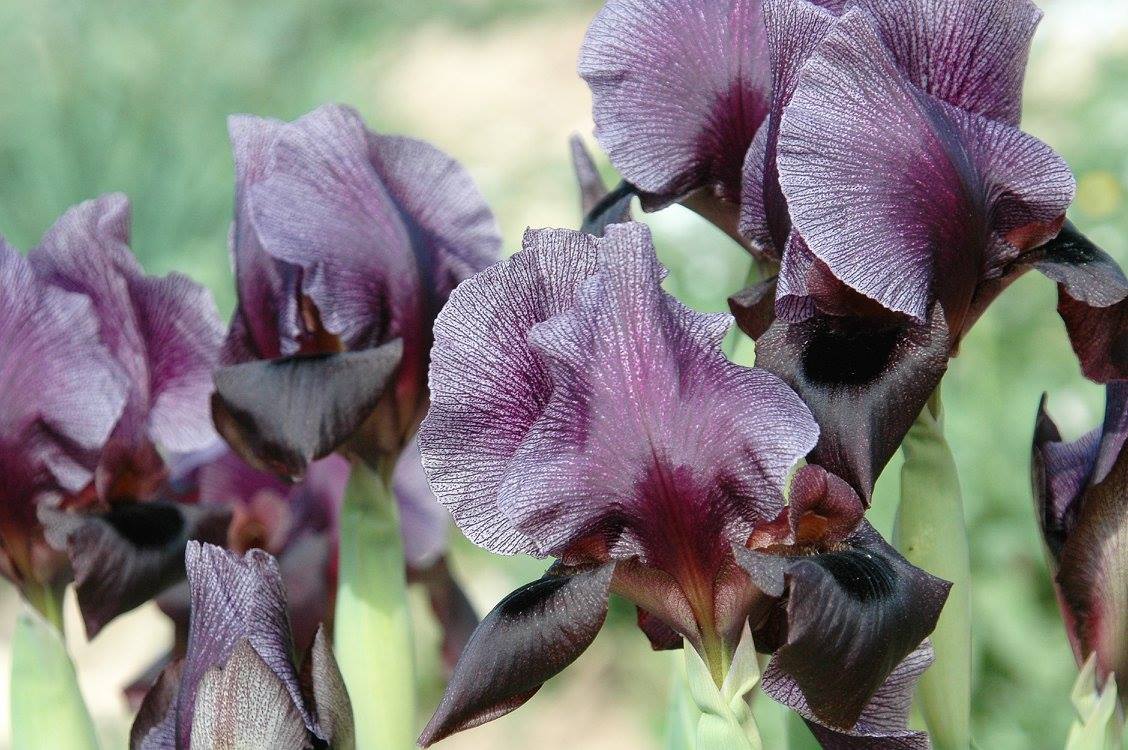
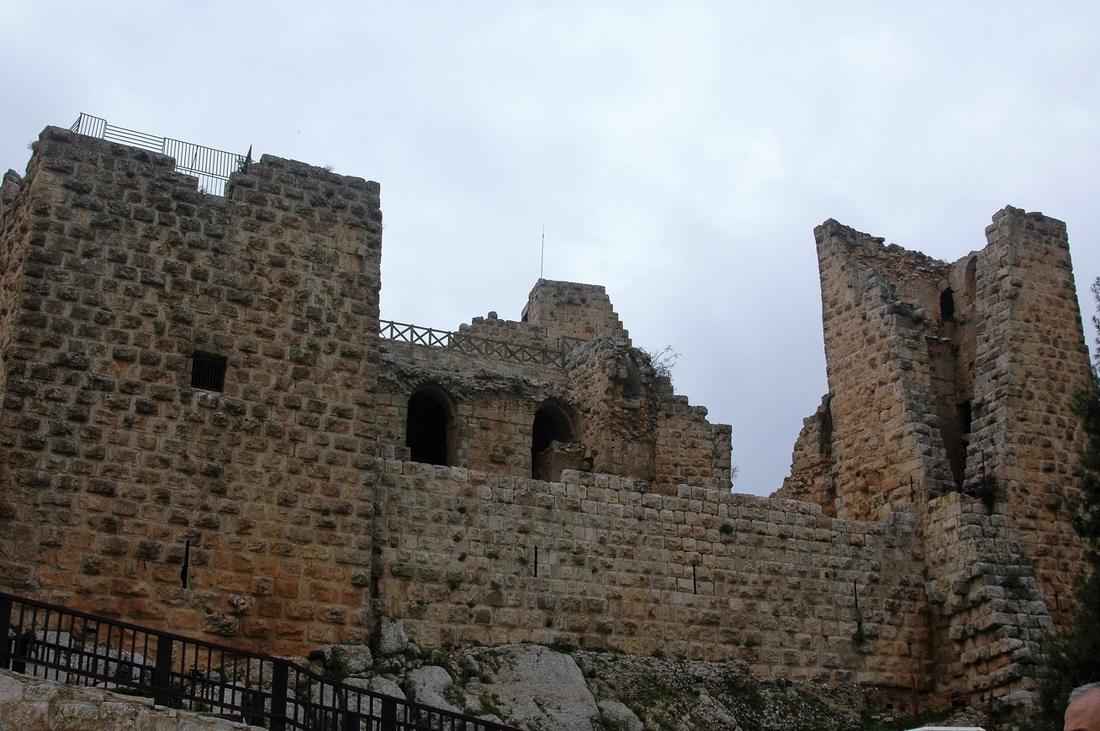
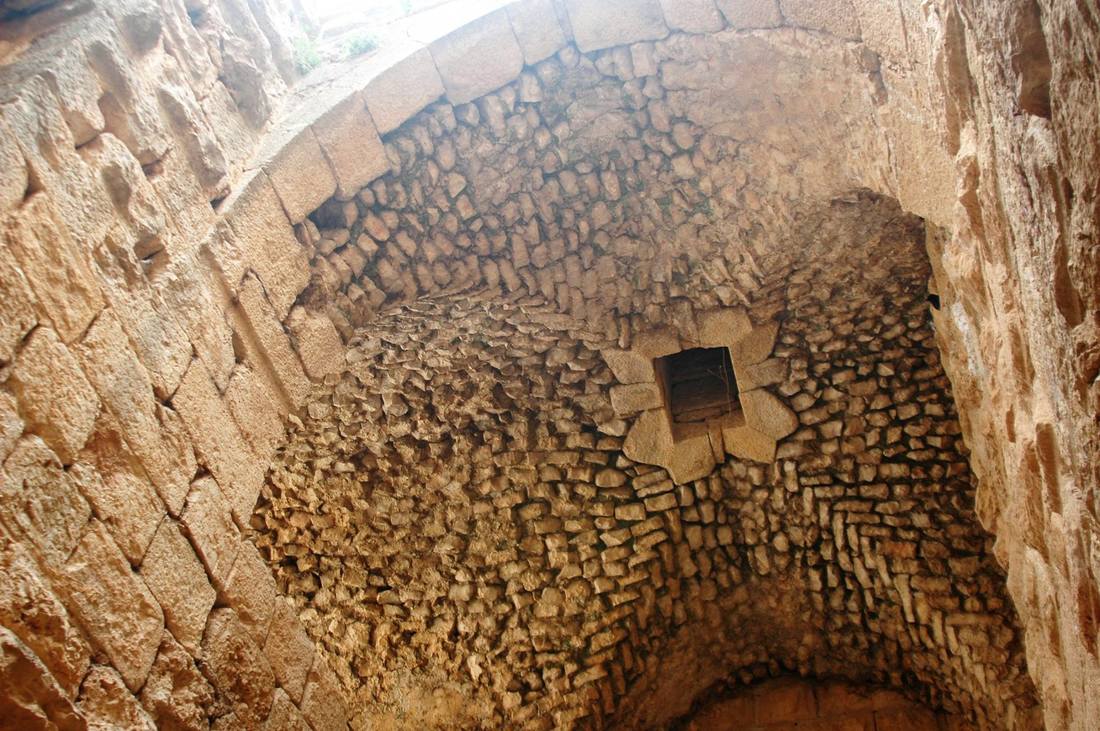
The following morning we visited the Arab-built Crusader period castle of Ajloun, a massive fortress built partly to protect the local iron mines. Normally this is a windy spot, but we had luck with a calm day, and we could gaze over familiar Mediterranean agriculture typical of northern Jordan – olives, citrus, oak plantations, vegetables, fruit trees, including pomegranate, figs, almonds and vines – interestingly the vines here are pruned three ways: to lie flat on the ground to catch the early season grapes, or tied to low fences, or on high pergolas to produce raisins late in the season. We could gaze north towards Syria, and remember that Jordan hosts many refugee camps not far from here. Yes, we were close to today’s troubled politics. But there was no reason not to feel safe in our wild locations.
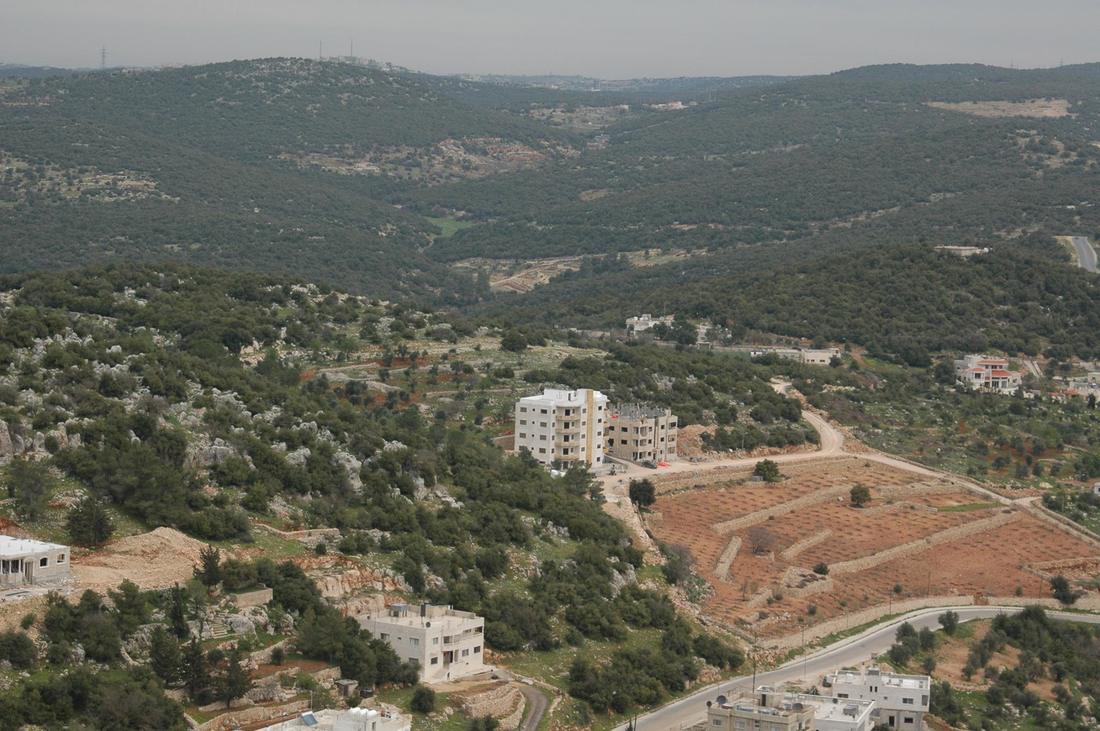
That afternoon we dawdled down a magnificent hillside dotted with Pavarotti-sized olive trees dating from Roman times, with immense often split girths. “I feel my roots in these olive trees,” Oron said with feeling, “Everything about the Mediterranean is here”. Indeed, he loves planting trees more than anything else. Tree huggers among us said they took energy from the ancient wood too, as they pushed hard against the gnarled trunks. Truly this was a beautiful wander – even if down a tough slope at the start.
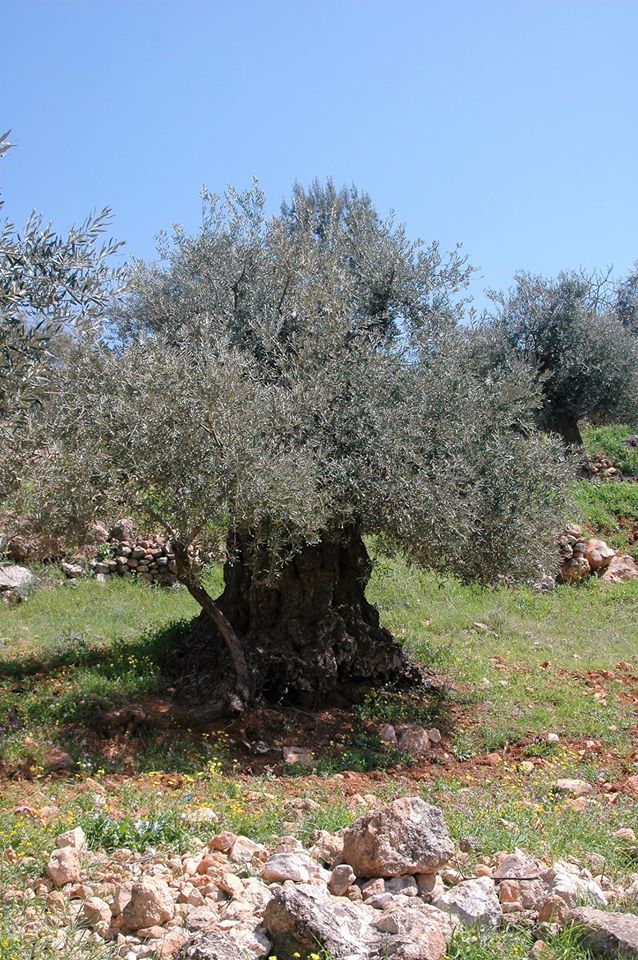
We spotted Ophrys umbilicata, gorgeous examples of and, at the bottom, another black iris species, this time the rare exotic Iris bismarckiana – (below, left) Oron knew exactly where to find this secret source that he originally discovered by accident. He says even if there are many plants on a single site, few of them bloom and they are reluctant to set seed. Not for the first time we admired
Retama raetam, (below, right) a most beautiful broom-like bush that seems to thrive in many habitats.
The Bedouin in the valley offered us delicious almonds with salt. Some of us staggered back up the slope, others fell into a car rather glad of the haul to the top. Would we ever find this magic valley again on our own, I doubt it.
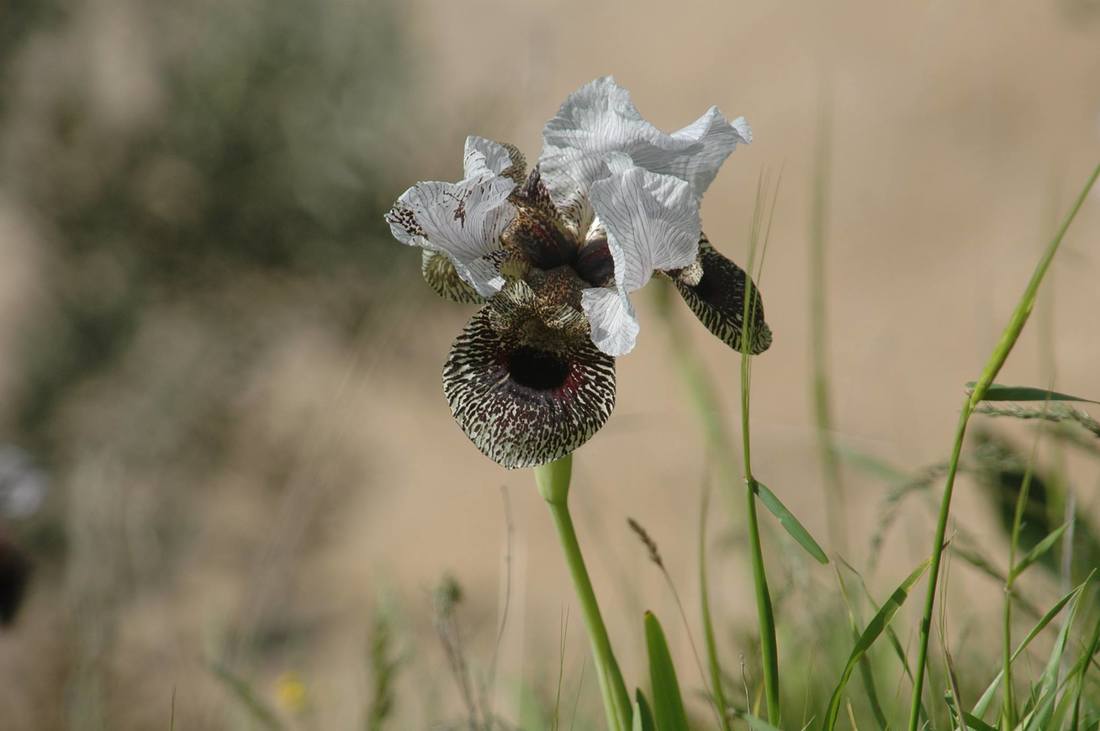
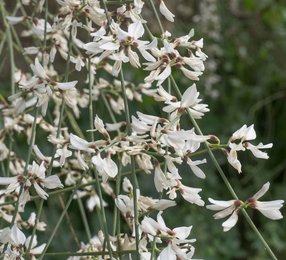
The afternoon offered a choice: the extensive Roman ruins at Jerash – often said to be the best preserved grand Roman city in the Eastern Mediterranean. We were practically the only visitors and in an afternoon barely scraped the surface. It was full of wildflowers – mainly crucifers and white anchusa. Its history is too long for this account. Go if you possibly can, it is a magnificent spot on a vast scale.
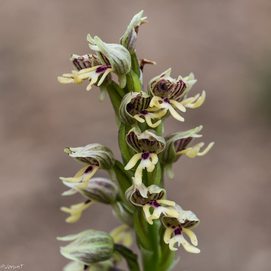
Others visited one of the last remaining pine-oak forests in the Middle East at Dibben and Becky Cross reports they found Ophrys umbilicata, Anacamptis papilionacea, Orchis galilea (left), Ophrys fusca yellow form also, Ophrys sphegodes subsp. Mammosa, Orchis anatolica. And she adds: “It was very dry overall but had moist areas from the various wadis running through the forest. The orchids were dotted around in clumps (terrestrials grow where they have the mycorrhizal fungi in the ground so often grow in communities), Oron knew exactly where to look of course! The Ophrys species were hardest to spot but once we saw one we kept seeing more.
“We also saw flowers of Cyclamen persicum, some really nice specimens. I hadn’t been expecting a forest habitat at all in Jordan so that’s why it stands out for me as an unusual, memorable highlight, it reminded me more of the true Mediterranean landscape like Portugal for example.”
The days were rushing past, and too fast. Our plans were altered because of a sudden Arab Summit on the Dead Sea. We left Mediterranean horticultural landscapes and headed back south (past numerous garden centres/nurseries – presumably to feed the gardens of Amman, to Wadi Mujib, another dramatic canyon. Oron suddenly seemed worried that we were not encountering enough varied wildlife, – true, there had not been many birds despite it being a migration time, so he took to lifting stones to reveal deadly scorpions (Death stalker scorpion, Leiurus quinquestriatus – hideously coloured and well advertising its fatal threats) and interesting beetles – many of them crucial pollinators.
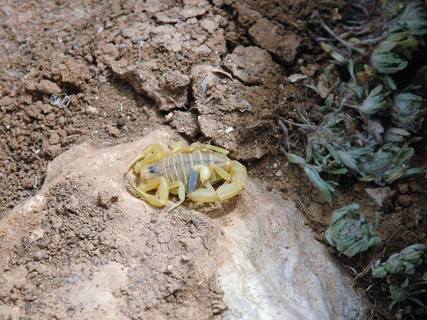
Going south again the desert landscape was sensational with vistas too wide and overwhelming to take in properly. How do plants, animals and people survive in this seemingly barren terrain? Well, we saw Bedouin camps and shepherds with their flocks on what looked like impossible to reach terraces – they looked perfectly fit. We found a tiny pale blue Convolvulus pentapetaloides, edible artichoke (Cynara scolimus), Melvyn spotted a palm fossil from a petrified forest, others discovered alliums, we noted scattered cypress trees and pines, and some evidence of drip irrigation, lovely dark violet Gladioli atroviolaceus, and hoopoes (Upupa epops) flying above our heads, and so to Karak (apparently the source of the best yoghurt in Jordan), by now further south of the country via the desert highway. We heard about phosphate mining (Jordan has few natural resources, this is one of them).
And next, to famous (and it must be said, immaculate) Petra, as much a highlight as the famed black irises. Well, millions of words and acres of photographs and film have been devoted to this city hidden in the Shara mountains – only discovered by a canny Swiss explorer in 1812 (he dressed up as a Bedouin, got their confidence, his hunch about a secret place paid off – this is a story in itself).
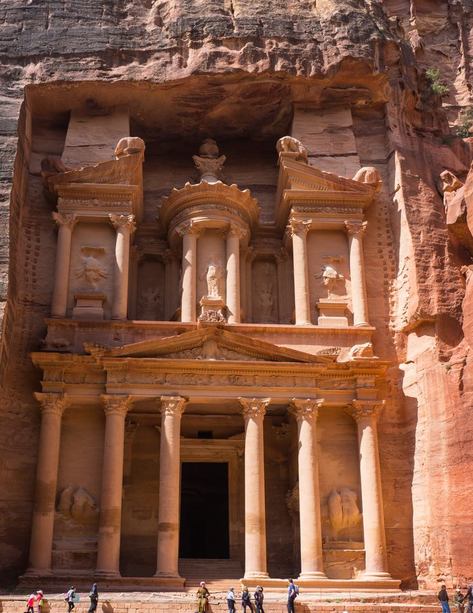
Even so, no description quite prepares you for the sheer physical impact as you walk (one and half kilometres) through the narrow canyon, the Siq, entrance to the ancient gorge to confront the early morning sun on the Immense Treasury building (this image, above, more reproduced than any other except perhaps the Monastery further down) carved out of the soft red sandstone – experts say the carving was approached top down to the ground where we stood 40 metres below.
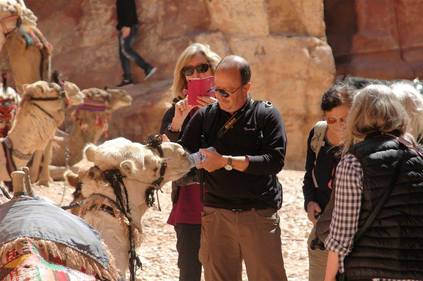
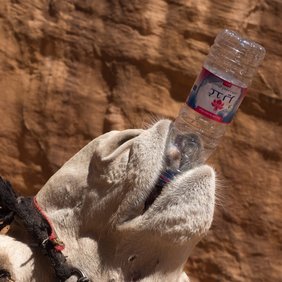
We jostled with camels, chariots, donkeys, dung (but no other rubbish), crowds off cruise boats anxious to take their selfies and be off, Oron fed a bottle of water to an enthusiastic camel which showed every sign of gulping the plastic too. We marvelled at the weathered rocks, the sheer vision of the place in its beginnings. As we began wandering from the Treasury down into the main site suddenly the crowds were gone – bad for tourist revenue but great for us.
Petra is over 2000 years old, dates are vague. It prospered as the capital of the Nabataean Empire from the first century BC as a trading centre for spices, myrrh and frankincense. Its buildings show Hellenic influence. Then the Romans took over until a massive earthquake in 363 AD (and a further quake in 749) and gradually it was abandoned, with only local Bedouin surviving in the many caves and burial chambers (below) carved in the mountainsides.
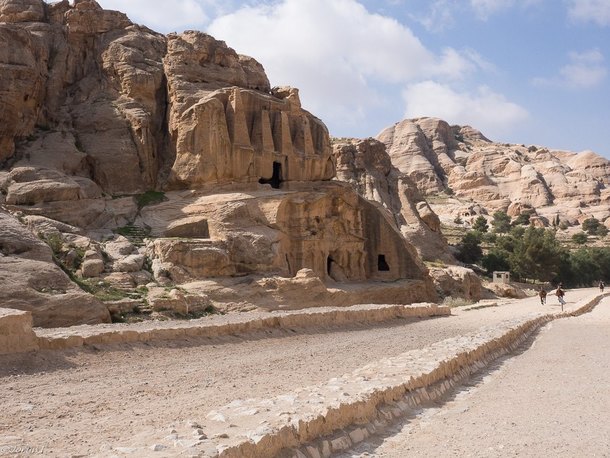
Much is written about the Nabataean’s brilliant choice of site for their secret city and particularly their skills as hydrological engineers, constructing an 88 metre tunnel to divert flash floods from the local wadis. And there is the sheer breath of their vision and choice of locations for key buildings dotted among the natural rocky canyon throughout the site. Although there is a main trail, it was delightful to be diverted into tombs (if we could reach them), caves, immense streets, a gigantic theatre, the great temple complex, the famous Monastery (800 steps each way for the frisky climbers among us), Roman mosaics, beautiful carvings and mysterious images, the utter beauty of the weathered rose-red rocks, turning crimson as the day wore on. And we had our best lunch at the bottom.
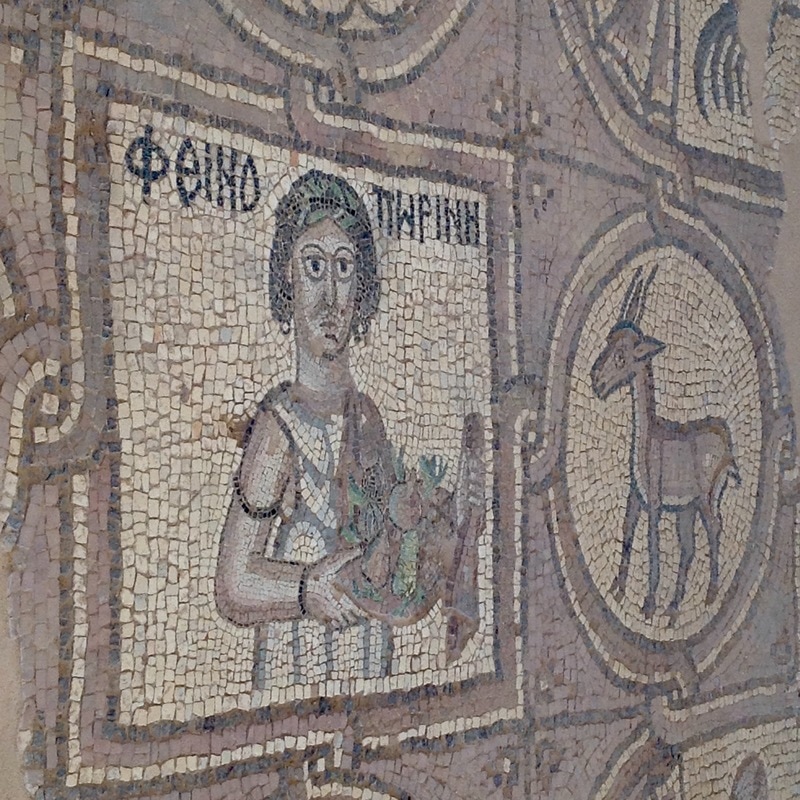
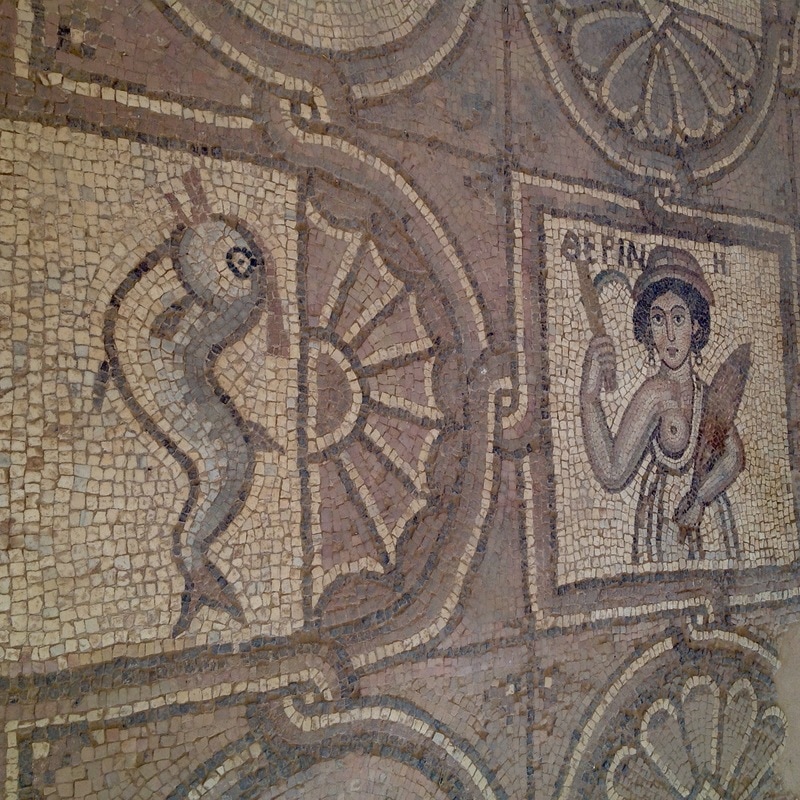
Also still here are today’s Bedouin who have the measure of their visitors – they are polite, extremely good humoured, with delightful often multilingual children who do a good job of peddling little bits of Petra pink rock or the declining trade of postcards. At one stage some of us were plant hunting with Oron – we spotted any number of beetles, geckoes, lizards and other beasties under stones.
A cheerful Bedouin woman took one look at some of us and assured Oron that the route down he was proposing was, “too dangerous – you go the steps way, you have old ladies with you, look at their old legs!” Of course she wanted us to pass by a little stall belonging to her family. “But I am married to all of them,” Oron said gamely, “they can manage!” The woman turned to us, “This man too young for you ladies, you need to marry old man who will die soon and make you rich!” Trivial obviously to record now, but symptomatic of the warm welcome and fun of the day. One point: Bedouin no longer live within the site; accommodation including schools has been built for them in a village above – probably not always to their taste, although doubtless providing better electronic coverage and education for their offspring. A book I am enjoying is ‘Married to a Bedouin’ by Marguerite van Geldermalsen, an Australian who fell in love and wrote an applauded account of the Bedouin lifestyle. Her children still run an interesting shop selling local crafts in the site.
A day in Petra offers no more than a hint of its wonders and history. Would I return? Oh certainly. For longer. Oron who has visited many times says he never tires of it.
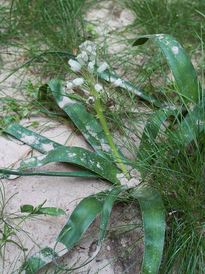
Next day we stopped at nearby Little Petra, once an important trading post for those en route to Petra proper. We spotted migrating kestrels, swallows, house martins, a common buzzard migrating north, a female Sinai rosefinch (Carpodacus synoicus) darting between rocks, and noted plants that had managed a foothold in improbable high places offering damp patches. There was plenty of Umbillicus intermedius (common pennywort), clumps of particularly healthy pink oleanders, and we were especially excited by a handsome Bellevalia stepporum – (left) this was a big photo opportunity.
It was time to start climbing towards the Dana Reserve, an incredible drive up and down and up again an almost deserted desert road with geology switching from limestone to sandstone to granite and back. We overlooked the Dana valley – with buzzards, possibly an eagle or a kite bound for Eastern Europe. Another beautiful downhill walk included spotting Euphorbia ramonensis, only found here apparently, and hundreds of little purple iris, now open wide to catch the afternoon sun. Particularly special was Arabis alpina, a beautiful white clumped brassica on its only known Jordan plot. We found a bugloss (Alkanet), its roots used for red dyes, we saw a beautiful Juniperus phoenicea that only manages to put on a centimetre a year.
Another glorious afternoon, led by an expert. Almost the end of our trip, and now a day in the desert at Wadi Rum – something to dream about in our rocking chairs. Goodness, it was beautiful. (Is anyone still reading this by now?)
Just as no one can visit Jordan without visiting Petra, so they surely should not even contemplate missing out Wadi Rum. Here is the desert of our cinematic dreams (Lawrence of Arabia was filmed here in the very spot where we silently watched a glowing sunset and where he was reputed to live). Vast granite, basalt, sandstone rocks in contorted strange shapes up to 600ft high – pink, grey, black, white – every colour as the day wore on, sand and silence as far as the eye could see. As everyone is warned, going into the desert alone without a Bedouin guide who can read the landscape like the back of his hand is a sure suicide bid. And so we climbed into the Bedouin’s trucks (our drivers on their phones all the while) and headed out into the sandy dunes.
Only a fool believes there can be no wildlife in these eternal landscapes – after all, the Bedouin have made a living for millennia, tending their animals and hunting. Time and again Oron stopped the convoy and we jumped out to inspect plants he’d spotted nestling in the sand, particularly parasitic plants such as Cynomorium coccineum parasitic on Zygophyllum, a plant that the Bedouin use for soap. Take a look at Jorun’s pictures for a flavour. We learned too how some beetles survive: their habit each morning is to do a handstand and catch the dew dropping over their bodies. Many plants obviously have the same techniques.
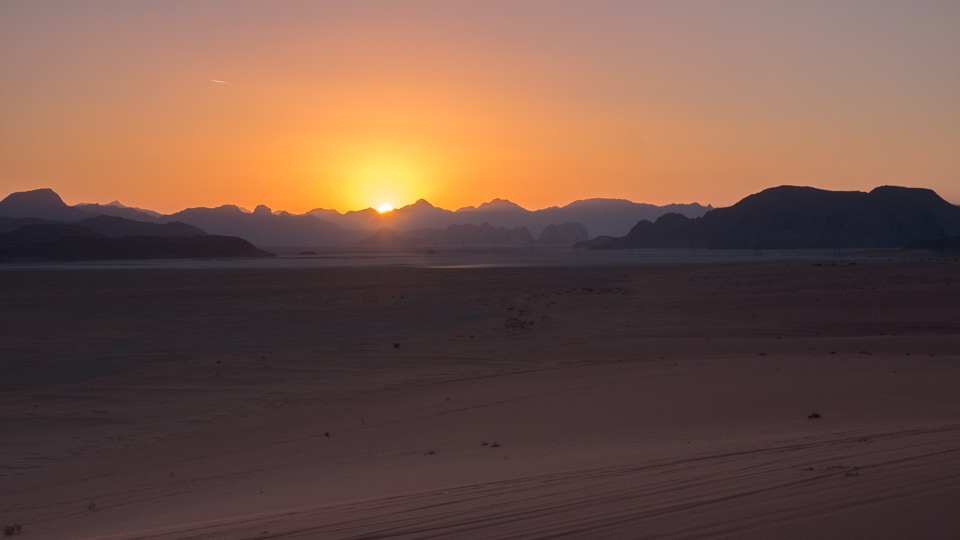
My desert truck driver was 33 or so with one wife and three children, the son of a father who’d had three wives and 29 children (and died young). He claims to be looking for further wives, preferably at least one with a house in Miami. Sometimes he lives with his family in the village, other times he spends the night in the desert with his 300 sheep, ten camels and numerous dogs. His phone and internet access are perfect, he says. With his brother and cousins he runs a successful tourism and herding business. The briefest snapshot of a once nomadic life here in transition. But for how long will further generations of Bedouin understand their landscape and its life so intimately?
We were entertained to Bedouin coffee in sight of one of the T E Lawrence desert bridges and visited ‘his cave’. No time now to debate the accuracy of the Lawrence myths, but the stories do offer a kind of focus in this endless miraculous landscape.
We took a detour to Aqaba to reflect on its strategic position on the Red Sea, Israel and Egypt to the west, Saudi Arabia to the east. It’s a big tourist resort, noted for its bird watching centre and diving. Finally we drove north to the Dead Sea and a salty swim, which some loved, and others found somewhat underwhelming.
Jorun I think summed up what most of us felt when she wrote:
“You asked us all if we could mention one or a few plants that were particularly interesting, and there were many, so it is difficult to choose. Of the irises, especially the Iris bismarckiana (22 March), were stunning, a friend of mine said that one alone was worth the whole trip, and I loved the Cyclamen persicum at the same place, I suppose these are on most of peoples’ top list. But if I should choose something entirely different, it would be the beautiful Acanthus syriacus (21 March), and the white, genista-like Retama raetam, which we saw in many places, that is something I would very much like to have in my own garden in Greece.
“But more than anything I enjoyed the company, most of you I had met before, but there were some very nice new acquaintances as well, and most of all, meeting the Jordanians, besides some extremely handsome men, whom I couldn’t resist photographing, all the people I met were so friendly and open, I really felt we were wished welcome there.”
Indeed, a most wonderful and memorable week. Thank you everyone!
Juliet Walker
Photos: Becky Cross, Melvyn Jope, Jorun Tharaldsen, Lesley Whayman

